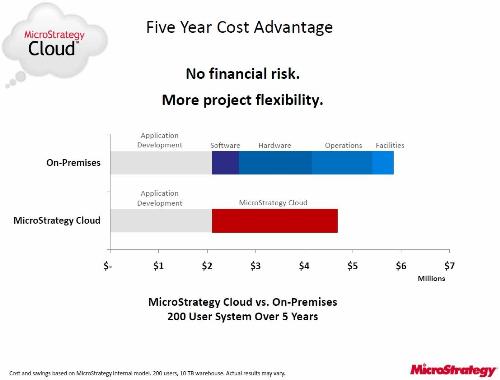
From the BI Scorecard: MicroStrategy’s Unique Approach to Cloud BI
MicroStrategy Cloud promises to be as easy to get up and running as current SaaS offerings but with all the BI robustness of its traditional on-premise solution.
- By Cindi Howson
- September 20, 2011
“Cloud” has been on my mind. When mainstream media declares “cloud as mainstream” and yet, businesses are still hesitant and confused, it’s hard to resist the hype. Everyone from NPR to
USA Today to
Forbes is talking about the cloud.
Vendors big and small are trying to make “cloud” a household word. For the most part, such hype seems to be falling flat on the ears of IT professionals. Microsoft’s commercials touting “To The Cloud” are generally met with puzzled looks by anyone outside of IT. (As if moving to the cloud were the end game!) Apple’s recently launched iCloud is justifiably appealing to consumers trying to synch content across multiple devices. However, when it comes to cloud BI, the reactions and understanding differ. A survey by TDWI last year found that only 9 percent of BI professionals were “very familiar” with cloud BI. (Share your thoughts on Cloud BI
in this survey.) If so few professionals understand the promises and the pitfalls of cloud BI, we have a long way to go before it becomes a commonly considered option in deploying BI.
Cloud BI is exciting for its promise of faster deployment, lower entry costs, and elastic scalability. To date, cloud BI efforts have blended purpose-built software with cloud infrastructure. Solutions such as PivotLink, Birst, and Indicee all have their own application layers. Customers buy these solutions for both the front-end capabilities and for their Software-as-a-Service approach. SAP BusinessObjects BI onDemand is a little bit different in that it supports sharing of documents created in Xcelsius and Crystal Reports, but is not as robust as the on-premise SAP BusinessObjects suite. Meanwhile, MicroStrategy Cloud promises to be as easy to get up and running as current SaaS offerings, but with all the BI robustness of its traditional on-premise solution.
In the BI world, one of the biggest pain points for companies just beginning to deliver BI is the initial deployment. For the most part, BI software is painful to install and configure. Configuring BI for thousands of users and for extranet deployments requires specialist skills that are not required on an ongoing basis. Expertise in designing data models and authoring reports and dashboards, on the other hand, are skills to invest in and needed on an ongoing basis. With a cloud BI environment, the vendor provides the infrastructure and the software. Customers pay to use the service on a monthly or yearly basis. The work and expertise seem more smartly divided, but concerns about security, loss of control, and general lack of knowledge abound.
MicroStrategy has taken a different approach than current BI SaaS offerings on a number of points. First, it is using its own data centers, whereas SaaS BI startups tend to rely on the Amazon Cloud. MicroStrategy says for now it will own the infrastructure to be able to control performance. The data centers are powered by Cisco, NetApp, and Dell hardware. The vendor will invest $100 million in the data center infrastructure over the next three years. As MicroStrategy has long been known for its enterprise capabilities and data scalability, I can understand why the company wants to keep a tight rein on its cloud offering. However, I question if managing data centers moves too far beyond the company’s core competency.
MicroStrategy also is blending its cloud approach, allowing customers either to keep their data on-premise (and use the cloud only for the MicroStrategy application layer) or to load the data into the cloud. This addresses one of the biggest fears about cloud: who controls the data. Few other SaaS BI vendors allow such a hybrid approach, although Birst was one of the first to introduce it back in 2009. With the full-cloud implementation, MicroStrategy has partnered with IBM Netezza for the BI appliance, ParAccel for the columnar data base, and Informatica for ETL capabilities. I would imagine small to midsize businesses as well as departments that lack their own IT resources would find this latter approach to cloud BI appealing.
In an era of SaaS vendors who tout their multi-tenant architecture as being “SaaS ready,” I am concerned that MicroStrategy is not multitenant. In the post-mortem on one-time SaaS vendor Lucid Era, its single-tenant architecture (and higher costs to maintain) was cited as one of the reasons for failure. Architects can get religious in their arguments for and against. The “for” multitenant arguments: multiple clients on a single set of hardware, shared-everything infrastructure makes it easier and cheaper for the SaaS vendor to maintain the environment. The “against” arguments: customers want to customize their own environments and fear sharing anything. MicroStrategy Cloud will be using virtualization, with multiple companies on the same hardware, but each in their own virtual environment.
For any SaaS solution, the question continues to be: what’s the cost/benefit analysis? Is SaaS more expensive over time than if the solution were deployed on-premise? MicroStrategy presented a cost/benefit analysis for 200 users over 5 years (see Figure 1), with over $1 million in savings. The product was released in July, so it’s too early to tell what the real-world case studies will show.

Figure 1: Cost/benefit analysis for 200 users over 5 years Source: MicroStrategy (used by permission)
Click to enlarge |
I will be curious to see what the uptake is, and if it will be at small to midsized businesses that lack IT resources or in departments in enterprise companies looking for faster deployment options?
What is your level of interest in cloud BI? Take the 10-minute survey here.
Regards,
Cindi Howson